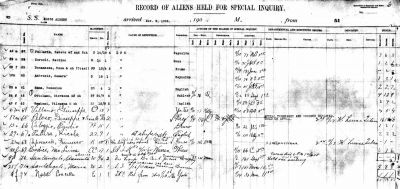Knowing the moment your ancestor first stepped foot in America is an exciting piece of family history and Passenger Lists tell us exactly when it happened. When I first started researching passenger lists, I only focused on the name of the steamship and the date of arrival. However, the more I learned about the information that was recorded in these documents, the more excited I was to discover several annotations made on the lists that earlier I had overlooked. Learning what these annotations meant made the stories I was trying to record much more interesting. Over the next few months, we are going to explore the century-old secrets that passenger lists may contain. We will look at the various notations immigration officials marked on the lists. These annotations are best explored by separating them into two categories – those made at the time of immigration (contemporaneous) and those made after immigration (post-immigration). This month, we will focus on contemporaneous annotations to determine if a U.S. immigration official detained a passenger.
How Passenger Lists Were Created
Typically, the steamship company’s purser prepared the lists. At the steamship office located at the departure port, the purser asked each passenger several questions and recorded the responses on the list. Occasionally, you find a passenger’s name that appears to be lined out. This means that the passenger did not sail perhaps due to: the passenger missed the ship’s departure, was too ill to travel, failed a health exam by the steamship company’s physician, or a problem with the traveler’s ticket or documentation.
The Detention Process
Once an immigrant arrived in America at the immigration station, he or she was required to undergo an inspection by an immigration official. The official was looking for various reasons that might result in detention or deportation. If the immigrant did not pass inspection, he or she would be detained and go before the board of special inquiry for a determination. Not all immigrants who were detained had to have a hearing. For example, a woman traveling alone was sometimes held until someone arrived to meet her at the immigration station to ensure her safety.
Annotations of Detained Passengers
If a passenger was detained, you will likely see an “X” next to the passenger’s name in the left margin. You may also see “S.I.” or “B.S.I.” which indicates that the passenger was held for a hearing before the Board of Special Inquiry. Other annotations that indicate detention are “Held” or a “D.”
Lists of Detained Passengers
When you see the annotations indicated above for a passenger who arrived in the port of New York after 1903, your next step should be to scroll to the end of the passenger lists for that voyage. Here, you will find either “List of Aliens Detained” or “List of Aliens Held for Special Inquiry.” In these lists, you will find more details such as the reason for detention, how long the detention lasted, how many meals were served to the passenger while in detention (detainees were not charged for the meals but records for financial accounting purposes were kept so that their steamship company could be billed), and the outcome of any temporary detention or hearing. If the immigrant was held due to illness, look for “In Hospital.” If the passenger was discharged, it will be annotated. Unfortunately, some passengers died at the time of immigration noted as “Died in Hospital.”
Another note you might see for an ill passenger is “Med Cert,” the annotation for the issuance of a “Medical Certificate” by a Public Health Service physician who determined that the immigrant suffered from a "loathsome or a dangerous contagious disease." If it was an infectious disease such as tuberculosis, venereal disease, trachoma, or favus, deportation was mandatory.
If an immigration inspector had concerns about the ability of the immigrant to support himself or herself based on physical or mental condition or age, the immigrant could be held out of concern that he or she could become a “likely public charge” annotated as “LPC.”
Women who were traveling alone or with minor children and did not have someone to meet them at the port were also held until a relative arrived or responded to a telegram that they were able to receive the passenger. For these situations, you will see in the Cause of Detention column annotations such as “To bro” which means that the passenger was to be sent to her brother or he was to come and pick her up. If you see “To tel $” it means that the passenger was held because he or she did not have a ticket to his or her final destination nor money to purchase the ticket. In these situations, the immigration officials sent a telegram to the passenger’s contact in the U.S. asking for money to be sent. Once the money was received, a ticket was purchased and the passenger was released. The time and date of discharge is also listed on this document. Next month I will share more passenger list secrets. Until then, happy researching!



